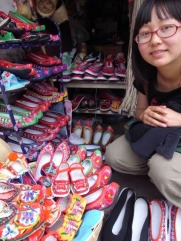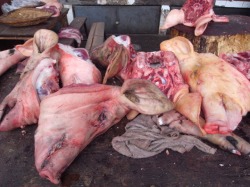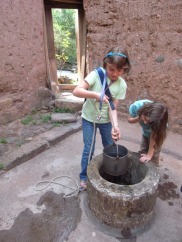
Ali and Sue in the park
We paid our second visit to the small town of Weishan, in Dali Prefecture. Our discovery of yet more old and well-preserved buildings and parks left me with a conundrum - how did Weishan survive the ravages of the Cultural Revolution to a much greater extent than other places we have visited, even compared to Dali old town. Many old murals, wood carvings and painted pillars that date back to before the 1970s remain intact. Another puzzle is why the people of Weishan are still living in traditional wooden houses and renovating old ones, rather than ripping them down like there's no tomorrow and replacing them with white-tiled monstrosities. The Government, apparently, is devoted to preserving Weishan's architectural heritage. What's more, the community, by and large, supports this. There are tight building restrictions and occasional grants for home improvements.
I don't believe that the same government was in power in the '70s but perhaps the anti-CR part of the community was stronger than those inclined to take up the mantle of the Red Guards? Loss of architecture is not just the result of destructive idealist fanatics however. Last month a fire (consequence of Yunnan's current drought) broke out on Wei Baoshan (the local sacred mountain) and burnt down the highest and oldest temple. All that remains is a thick wooden door frame.
I don't believe that the same government was in power in the '70s but perhaps the anti-CR part of the community was stronger than those inclined to take up the mantle of the Red Guards? Loss of architecture is not just the result of destructive idealist fanatics however. Last month a fire (consequence of Yunnan's current drought) broke out on Wei Baoshan (the local sacred mountain) and burnt down the highest and oldest temple. All that remains is a thick wooden door frame.

Katrina with Weishan shoes
We first discovered Weishan when we arranged to visit Li Yanhui (Katrina), who graduated from Simao Teachers' College in 2008. I first met Katrina in 2005, when she attended a VSO workshop in Kunming, along with me and Chen Yong. I taught Katrina when she was in Grade 2 (Vision and Listening) and Grade 3 (Writing) but we lost touch after that, until a chance encounter through another graduate. Weishan is her hometown, where she lives in a traditional timber home that's been in her family for three hundred years.
When Sue and Ali headed to Dali yesterday morning, Freda, Edie and I decided to stay in Weishan for another day, to spend some more time with Katrina. We visited her mum in the market, where she sells salted ham. We also spent time discussing Katrina's work and study aims. Although she graduated as a teacher, she has been unable to get a teaching job. She is currently working for the local government, in a small village nearby. She's on the lowest rung of the ladder and can be asked to do anything from office work to sweeping leaves up on the village square. She relies on an evening phonecall from the village leader to tell her when she must arrive at work the next day. In hope of promotion, Katrina took some exams in April. A high score will secure her a leadership post. This means she will have plenty of time in a remote village sitting at a computer.
She hopes to set up an internet business, selling Weishan handicrafts, such as these embroidered shoes. Her aim isn't to become rich, but to have some autonomy and promote her local culture. Meantime she is still studying for her teaching exams in August. To become a teacher is her main goal. I find it sad that such an out-going, open-minded and capable graduate should find it so hard to get a job, as a result of a recruitment system that cares for nothing but exam scores. What's more, the exam they must pass cares nothing for but theory and lucky guesses in multiple choice. Teaching aptitude and character stand for nothing.
When Sue and Ali headed to Dali yesterday morning, Freda, Edie and I decided to stay in Weishan for another day, to spend some more time with Katrina. We visited her mum in the market, where she sells salted ham. We also spent time discussing Katrina's work and study aims. Although she graduated as a teacher, she has been unable to get a teaching job. She is currently working for the local government, in a small village nearby. She's on the lowest rung of the ladder and can be asked to do anything from office work to sweeping leaves up on the village square. She relies on an evening phonecall from the village leader to tell her when she must arrive at work the next day. In hope of promotion, Katrina took some exams in April. A high score will secure her a leadership post. This means she will have plenty of time in a remote village sitting at a computer.
She hopes to set up an internet business, selling Weishan handicrafts, such as these embroidered shoes. Her aim isn't to become rich, but to have some autonomy and promote her local culture. Meantime she is still studying for her teaching exams in August. To become a teacher is her main goal. I find it sad that such an out-going, open-minded and capable graduate should find it so hard to get a job, as a result of a recruitment system that cares for nothing but exam scores. What's more, the exam they must pass cares nothing for but theory and lucky guesses in multiple choice. Teaching aptitude and character stand for nothing.



 RSS Feed
RSS Feed